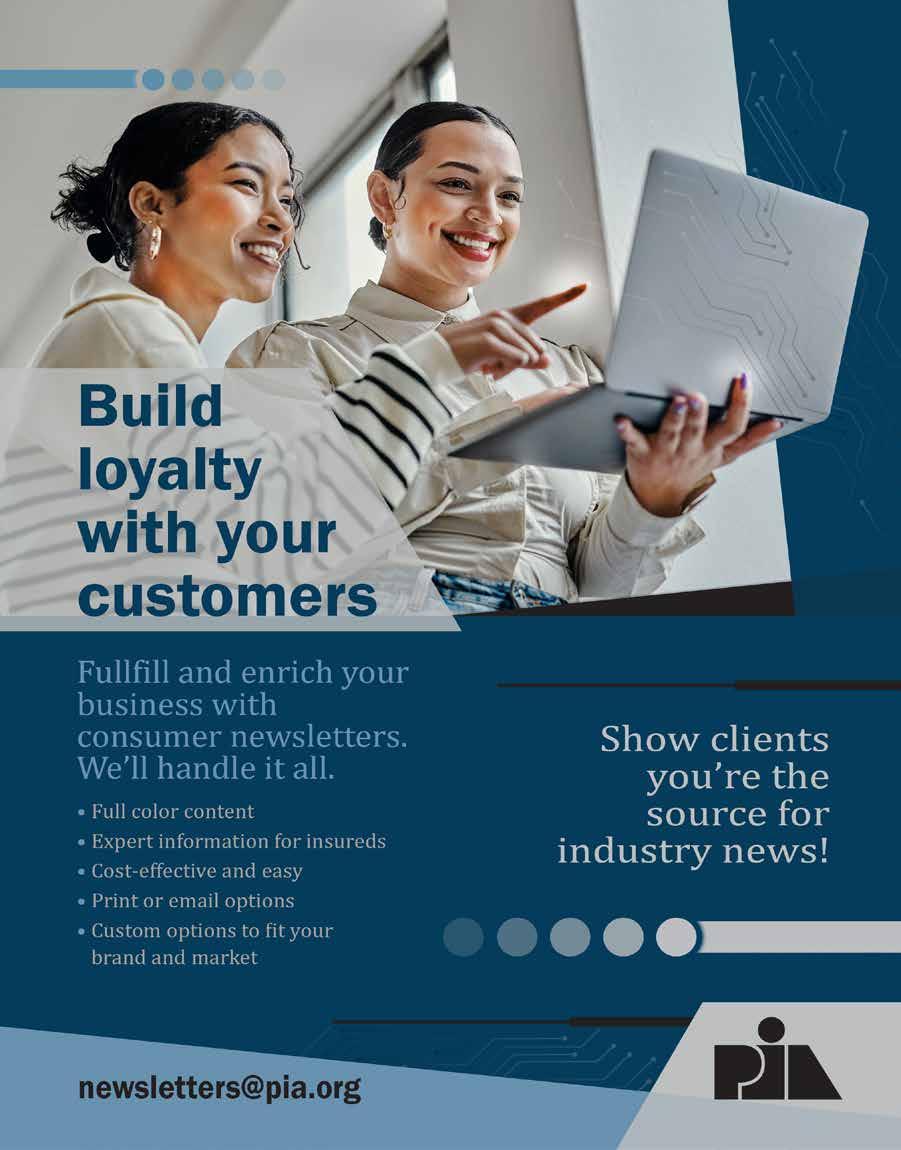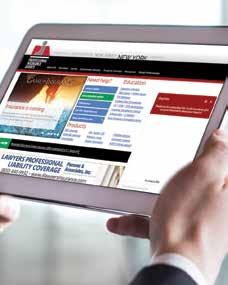

post-pandemic marketplace
Brooks Insurance Agency is proud to support Professional Insurance Agents (PIA)
Since its founding in 1991, Brooks Insurance Agency has successfully serviced the standard markets and brokered distressed and complex lines of business. We are here to help agents find the coverage their clients need.
We represent 80+ quality carriers, including several new and exciting markets, across the country. Plus, a broad array of products and services in admitted and non-admitted markets.
MARKET STRENGTHS AND EXPERTISE
• Broad market reach
• High-touch broker specialists
• Easy, online quoting process
• Collective approach to complex insurance needs
Visit our website at www.brooks-ins.com.
Brooks Group Insurance Agency, LLC NJ License 1575143
BROOKS IS YOUR FULL-SERVICE WHOLESALER
How can we help you? Call us at 732.972.0600 or email us at info@brooks-ins.com
2024 • New Hampshire
18 The post-pandemic marketplace
Attracting employees and next-gen agency owners
25 Master the art of giving How agencies can develop a culture of philanthropy
Statements of fact and opinion in PIA Magazine are the responsibility of the authors alone and do not imply an opinion on the part of the officers or the members of the Professional Insurance Agents. Participation in PIA events, activities, and/or publications is available on a nondiscriminatory basis and does not reflect PIA endorsement of the products and/or services.
President and CEO Jeff Parmenter, CPCU, ARM; Executive Director Kelly K. Norris, CAE; Communications Director Katherine Morra; Editor-In-Chief Jaye Czupryna; Senior Magazine Designer Sue Jacobsen; Communications Department contributors: Athena Cancio, David Cayole, Jeana Coleman, Patricia Corlett, Darel Cramer, Matthew McDonough and Damon Whimple.
Postmaster: Send address changes to: Professional Insurance Agents Magazine, 25 Chamberlain St., Glenmont, NY 12077-0997.
“Professional Insurance Agents” (USPS 913-400) is published monthly by PIA Management Services Inc., except for a combined July/August issue. Professional Insurance Agents, 25 Chamberlain St., P.O. Box 997, Glenmont, NY 12077-0997; (518) 434-3111 or toll-free (800) 424-4244; email pia@ pia.org; www.pia.org. Periodical postage paid at Glenmont, N.Y., and additional mailing offices.
©2024 Professional Insurance Agents. All rights reserved. No material within this publication may be reproduced—in whole or in part—without the express written consent of the publisher.

Reach your new Gen Z employees and clients
Looking to hire Gen Z?
Gen Z job seekers want: A progressive workplace. When was the last time you:
o Examined your agency’s culture?
o Updated your agency’s technology?
o Refreshed your agency’s missions, visions, values statement?
A diverse company culture.
To make your agency more inclusive:
o Post job openings outside your known sphere of influence. Referrals from current employees to fill open positions are great, but they can lead to a homogeneous workplace.

o Address your unconscious biases. Candidates with white-sounding names are 50% more likely to receive interview requests compared to candidates with ethnic-sounding names.




Software programs can help combat hiring bias, such as: Unbiasify Chrome Extension, Textio and Gender Decoder
o Invest in mentorship/internship programs. Most businesses’ mentorship and internship programs tend to overlook women and other minorities. However, the businesses that do emphasize these programs, have a 9%-24% increase in minority representation in management.
• Attend recruitment fairs in your area (at colleges and universities or hosted by other organizations).
• Participate in panel discussions, and stay after the event to answer individuals’ questions.
Are you having trouble finding younger people to fill the open positions in your agency? You need to be posting your job openings where Gen Z is looking for jobs: social media and job search platforms.
Keep your website updated with the information that Gen Zers are looking for when they are researching a potential employer. Make it easy for them to learn about your agency’s values and mission.
The average person will spend roughly 90,000 hours working during his or her lifetime. Make your work environment a place that people want to spend that much time of their lives.
Looking to do business with Gen Z?
An Insider Intelligence report indicates that: Gen Z is made up of about 68.2 million Americans. They account for a little more than 20% of the U.S. population. They command about $150 billion in buying power.
Take the following into consideration when you are trying to attract Gen
Z clients:
Gen Z is even more tech-savvy than millennials:
Not only did they grow up using technology as an everyday tool, but Gen Zers used it for education and learning. This could mean that when they start to look for insurance, they start by looking for information online. Have you reviewed the material you have posted online to make sure it offers the information Gen Zers are researching?
Preferred social-media platforms:
Like most generations now, Gen Z is online. However, Gen Zers are mostly using YouTube, Instagram and TikTok. If your agency isn’t using these platforms to reach your clients and prospective clients, there’s a good chance that Gen Zers don’t know about your agency.
Highlight agency initiatives:
Gen Zers like to work with businesses that give back to their communities. Independent insurance agents naturally are a part of—and give back to—the communities in which they work and live. You don’t need to brag, but you don’t need to be quiet about your good works either.




The bottom line: If you are creating an agency in which Gen Zers will want to work, you will be creating an agency that Gen Zers will want to work with when purchasing their insurance policies, too.
Millennials, Gen Z: Connect with the next generation of insurance
By Michael Streit, president, EZLynx
Millennials and Gen Z represent the largest generation in history, and both generations are a largely untapped market for the insurance industry.
While the insurance world has been evolving, let’s face it, the processes can be clunky and cumbersome, which is not particularly attractive to younger, diverse candidates entering the workforce.
Research shows that millennials are not interested in working in the insurance industry, primarily due to a lack of understanding of the available opportunities. Similarly, Gen Z, which is entering the workforce, view the industry as complex and lacking in transparency.
For the future of insurance, we need millennials and Gen Zers to take on the gauntlet, but how can we connect with these generations and get them invested in careers in the insurance industry?
Let’s look at some of the factors they consider when searching for a job.
Embrace technology innovation
Millennials and Gen Z are the technology-driven generations. They appreciate workplaces that incorporate cutting-edge technology as they expect speedy and effortless tech experiences. Typically, the insurance industry is seen as behind the times, but to get both generations interested in insurance, agency owners can invest and demonstrate that they are using digital tools to improve workplace efficiency and streamline processes.
By embracing tech in day-to-day workflows, these generations see an opportunity for the insurance industry to level up and in turn, get excited about investing a future in insurance.
Offer work-life balance
While some millennials and Gen Zers crave in-office collaboration time, most prefer to work remotely, and some want a hybrid-work environment.
Of the millennials and Gen Zers surveyed in a report by Ivans, nearly 60% of respondents said they prefer to work remotely; 23% want to work in a corporate office, and 19% want a hybrid-work environment.1
This shows that these generations want a balance between their work and personal lives, which looks slightly different for everyone.
Insurance agency owners can provide the workplace flexibility these generations crave by implementing the use
of cloud-based technologies into their agency processes. It opens the opportunity for this new generation of employees to access necessary files and service their customers from anywhere, at any time.
Ultimately, providing the flexible work option will be a major advantage to agency owners who are looking to hire the younger generations.
Provide career development opportunities
Millennials and Gen Zers are constantly seeking opportunities to expand their skill sets and develop their careers. They want a clear career path, and they are interested in ongoing training and professional growth.
The insurance industry can attract these generations by offering mentorship programs, continuous learning opportunities and transparent progression pathways. These can range from technical skills to soft skills, such as leadership and communication.
Moreover, insurance agency owners who invest in software solutions for their agencies can provide additional career growth opportunities, enabling young insurance professionals to progress their technical knowledge in the insurance industry.
This can help the members of these generations gain a deeper understanding of the industry while providing technical tools that make them more effective and enable them to progress their careers in insurance.
Final thoughts
Connecting with the next generation of insurance talent requires thoughtful strategies that align with their expectations and aspirations.
A modernized approach toward technology, work-life balance and career development plays a huge role in attracting this younger generation.
By understanding their needs and investing in the right technology, those in the insurance industry can attract and retain these driven and tech-savvy individuals for a more dynamic and future-focused workforce.
Streit is the president of EZLynx. With nearly a decade of experience in private equity operations and an MBA from Harvard Business School, Streit has become well-versed in the mechanics of deals and integrations, offering invaluable insights and contributions to the insurance industry.
1 Ivans (tinyurl.com/azuwtxxx)








ALAINA SIMS Senior manager of Profile Analysis and Workflow, The Omnia Group
Succession planning: Map out your agency's future
Succession planning—the process of identifying and developing internal talent to take on future leadership roles within an organization—often is looked at as a lengthy, time-consuming exercise that is only necessary for big corporations and C-suite executives. However, succession planning can be a tremendous benefit for all levels of leadership and for all types of businesses, including insurance agencies—no matter the size.
Succession planning is especially vital to insurance agencies in today’s labor market. As reported in the U.S. Chamber of Commerce’s America Works Report,1 the U.S. Bureau of Labor Statistics estimates that half of the current insurance workforce will retire by 2036—leaving over 400,000 open positions. So, now is the time to prepare the next generation of leaders within your agency.
Some important reasons for implementing a succession planning process include:
Securing the future of your agency. If you want your agency to flourish tomorrow, you need to prepare today. Merely hoping that you will have well-equipped people to take the reins is a big risk that could potentially put the future of your agency in jeopardy. Taking the time now to discover employees with potential
Workers’ Compensation
We distinguish our Workers’ Compensation coverage by providing value-added services before, during, and after a claim.
Upfront loss control measures
Responsive claims handling
Facilitation of quality medical care
(when an accident does occur)
We’ve been successfully protecting our policyholders and their employees since 1983.
Our Workers’ Compensation policy is available nationwide except in monopolistic states: ND, OH, WA, and WY.

and setting them on a course to prepare them for eventual leadership responsibilities can help you feel confident about the success of your agency.
Minimizing business disruptions. Leaders leave their jobs for a variety of reasons—retiring, changing life circumstances, and taking a new role at a different organization, just to name a few. If you don’t have people with the right skills and experience to take their place, you risk significant disruptions to both your daily business operations and the services you provide to clients—disruptions that can lead to customer frustration, which invites the potential for them to switch to another agency. Having a succession plan in place helps ensure that you have qualified employees to fill those important positions at the right time, which can keep your agency running smoothly and your customers happy.
Retaining internal agency knowledge. When leaders leave, they often take years’ worth of institutional knowledge with them. Having a succession plan allows those tenured managers to capture and pass along that vital information to your agency’s up-and-coming class of leaders.
Fostering employee retention. Effective succession planning can bolster employee engagement and loyalty by showing your agency personnel that you are committed to their growth. Succession planning helps define clear career paths and opportunities for advancement for your staff members and it also helps provide avenues for training and talent development.
Bonus: In addition to retaining existing employees, agency leaders who offer continued learning and growth opportunities as part of their succession planning process can be appealing to younger generations within the workforce and help bring in a new wave of professionals. Less than 25% of the insurance industry is under 35 years old,2 and a study by Pew Research found that only 4% of millennials show an interest in working in insurance, so this is particularly important to combat the industry’s scarcity of young talent.
Now that you’re convinced of the importance of succession planning, here are four steps to help you jumpstart the process at your agency:
No. 1: Identify key positions and any talent gaps. Determine the roles that are essential for the future sustainability and growth of your agency and the knowledge, skills, and experience that are necessary to perform these roles well.
No. 2: Create a talent pool within your agency. Identify employees who either already possess or show strong potential to develop the necessary qualities for taking on those key positions within your agency. Some ways you can do this are through performance evaluations, 360-degree feedback (receiving performance input from supervisors, peers, staff members and sometimes customers), and skills assessments. Behavioral assessments also offer valuable insights into a person’s intrinsic traits, strengths and motivators—all of which can help you determine if someone is the right fit for leadership.
No. 3: Offer training and development opportunities. Invest in the employees in your acceleration pool by providing leadership courses, coaching and mentoring, on-the-job training, and other opportunities. Consider allowing them to cross-train with others within the agency and to rotate through various positions to give potential future leaders a well-rounded understanding of the business. Use the information you gain from their performance
feedback and behavioral assessments to tailor development plans based on their individual strengths and challenge areas.
No. 4: Formalize a succession planning process. Document your succession plan; outline your process to identify high-potential employees and create development and training plans, as well as the timelines for leadership transitions. Communicate this process to your employees, and emphasize your commitment to growing internal talent for the future of your agency.
You know the old adage: If you fail to plan, you’re planning to fail. Don’t leave the future of your agency and your valued employees to chance. Implementing a succession planning process helps prepare your agency for long-term success by ensuring continuity in leadership and organizational stability while contributing to a resilient and adaptive culture and positioning your agency for sustained growth. Now that’s success ion planning!
Sims is the senior manager of Profile Analysis and Workflow at The Omnia Group, an employee assessment firm providing the power of behavioral insight to help organizations make successful hires, develop employees to their full potential, and effectively engage staff. PIA Northeast members receive discount pricing on Omnia’s Custom Profile and Target products. For more information or to try a free assessment, visit us at www.OmniaGroup.com, email info@omniagroup. com, or call (800) 525-7117, and mention your PIA membership.
1 U.S. Chamber of Commerce, 2021 (tinyurl.com/y45rykaz)
2 Forbes, 2023 (tinyurl.com/bdhhpdte)








AMY C. WANINGER Founder & CEO, Lead at Any Level
Unconscious bias training won't change your culture RISKS
You may have heard that diversity and inclusion training doesn’t work. (Everyone seems to be saying so.) For some businesses, that may be true, especially when there is a lack of commitment to real and lasting progress. But unconscious bias training can’t do all the heavy lifting on an organization’s behalf. Getting intentional about this work requires us to take it seriously.
Unconscious bias training is not enough
A lot of business owners say that they’ve invested in diversity and inclusion training, by which they mean some percentage of their employees completed unconscious bias training. Often, the training is delivered as a self-paced, online course that uses click-through rates as its only measure of success.
Unconscious bias training can be an effective starting point for people to be aware that biases exist in their workplace. That’s not a horrible thing for people to understand. But too many business owners stop there. They might say, “Well, we did unconscious bias training and nothing changed. At least we tried.”
Sadly, unconscious bias training often doesn’t go far enough. It’s true that unconscious bias is part of the

TRAVEL AGENTS AND TOUR OPERATORS
PROFESSIONAL LIABILITY PROGRAM
• Brokers - No minimum premium volume requirements to place business in this program
Partner with Aon Today!
45+ years serving the travel industry
• Recognized industry partner with top national travel associations
• Custom policy specifically designed for the travel industry
Professional Liability Insurance for:
• Travel Agents and Travel Agencies
• Standard Tour Operators
• Student Tour Operators
• Adventure Tour Operators
• Receptive Tour Operators


• Destination Management Companies
• Meeting Planners (Corporate)
Policy Includes:
• Worldwide Territory
• General Liability
• Errors & Omissions
• Non-owned & Hired Auto
• Personal Injury
• Industry specific endorsements
Learn more at www.aontravpro.com/broker
human condition. That’s how our brains operate. What employees (and especially leaders) need to know, though, is how to get past unconscious bias, and how to interrupt the patterns that lead us to bad assumptions about ourselves, other people and processes.
Measure something meaningful
When business owners ask me for unconscious bias training, I always ask, “What are your measures of success?” and “What results do you want to see from this?” The answers usually are telling:
Participation metrics. If the training is not mandatory, you’re not reaching the people who need it most. (On the other hand, if the training is mandatory, you need a strong communication plan before, during and after the training.)
Audience feedback. Some people will love that you’re doing this training. Others will be upset about it. If you want to effect real change, your training initiative can’t be a popularity contest.
Vague and wide-reaching cultural change. No lunch-and-learn in the history of corporate training can accomplish this. Keep reading.
We must start somewhere. You’re already starting from somewhere. But do you know where somewhere is? Have you taken a baseline measurement to find out who feels included in your organization, who doesn’t, and why? If not, you’re focused on activity instead of impact. You’ll spend a ton of money without knowing what you got for your investment, and executive support will dry up.
If you don’t know the results you want to see, and you don’t know what you want people to do differently, you are doomed to fail. Similarly, after the training, if you don’t ask people to do anything differently, the training is doomed to fail. You’re essentially running a track meet with no starting blocks and no finish line.
Do piano lessons work?
Take diversity and inclusion out of the picture and think about playing the piano instead. If you wanted someone to come in and teach your entire organization how to play the piano, you wouldn’t expect them to accomplish this feat in a one-hour lunch-and-learn on a Tuesday in July.
First, if you wanted your whole team to learn to play the piano, you would have to have a good reason for doing so. It would need to be tied to your mission, vision, values, and organizational goals, or the expense would never be approved. There would need to be a clear justification beyond: “We think our competitors are doing this.”
Second, you’d have a clear definition of success. Do you count it as a win if half your employees can play Mary Had a Little Lamb with 80% accuracy? Is the initiative only successful when every person can replicate Thelonious Monk’s level of performance?
Next, you’d invest in the right tools and training. Your employees would need access to pianos. You’d give them all the sheet music that they needed.
They would need to know how a piano works, and how the keys respond differently to different levels of pressure. You would approach written music as a new language. Your trainer would introduce music theory, a little at a time. But you wouldn’t stop there.
You’d get them playing the piano so they could hear what it sounded and felt like. They would practice scales and arpeggios, learning a few notes or simple songs so they can see progress early. Then you would expect them to practice, graduating to more difficult material over time. You would see them gain proficiency and confidence, which would create a virtuous cycle of progress. If this were important to your organization, you would observe them playing piano, occasionally. Performance objectives would be set by proficiency at different levels of difficulty. You’d expect employees to mentor and coach others who need more help.
The bottom line: You wouldn’t expect people to learn to play piano from a one-time, one-hour, optional seminar. So why would you approach other types of training that way?
Waninger is the founder & CEO of Lead at Any Level, where she improves employee engagement and retention for companies that promote from within. She offers assessments, advisory services, and training on essential skills for inclusive leaders. Waninger is the author of eight books. Learn more at www.LeadAtAnyLevel.com.



AL DIAMOND President, Agency Consulting Group
post-pandemic marketplace
Attracting employees and next-gen agency owners
nce upon a time—in generations before our own—children followed their parents into their insurance agencies, and they became the next generation of agency owners. Tradition and common sense taught our children that the insurance industry was a great way to earn a living and be respected within our communities. Finding additional or replacement service and administrative employees was a matter of putting out the word and advertising. This method attracted sufficient candidates, which allowed us to choose the right people for the open positions. Then, it was just a matter of training them, so they understood how we wanted our agencies to operate.


Our children worked their way through the various positions in the agency, ending up as producers, and naturally taking over ownership and management positions when those in the older generation felt like retiring. And, the employees we hired worked for the agency for their entire careers.
Well, my friends, as Dorothy once said, “I have a feeling we’re not in Kansas anymore.”
The pandemic’s influence on the industry
The pandemic years and the extraordinary closing of businesses for as long as two years may have accelerated change within the insurance industry.
For instance, the government subsidies to businesses eased the severity of the economic impacts of the pandemic, and the subsequent subsidies to affected employees, and the changing work environments taught an entire generation of workers that they have more control over their working conditions than ever before. And, they became less likely to stay with the same business for the length of their careers.
Even without the pandemic, we were seeing this culture shift in the fluidity of workers, which caused many agency owners to merge or be acquired by larger, consolidated operations. Not just retirement-aged owners are giving up and selling to outsiders or internal employees—younger owners are selling their agencies, too. And, this rate has accelerated over the past 20 years.
But, now that the physical and political impact of the pandemic has eased, many agency owners are asking a similar set of questions about their futures:
1. Can we still recruit and develop our next generation of owners?
2. How do we recruit and replace employees when fewer candidates seem qualified for the position, and even less are willing to follow our agency systems and procedures?
3. How do we find candidates who want careers in insurance, and who will treat our customers the way we expect?
The answers to these questions can be found in this statement: The insurance product delivery system is changing. Either we must change the way we recruit and motivate our successors and younger employees, or we must step aside and let a new generation (internally or externally) develop the agencies instead of the current owners.

The new agency
The insurance agency system will continue. It will provide strong earnings potential for more generations of agency owners. However, it will look different than our agencies and those of past generations. One difference will be the continued advancement in agency and carrier automation. Clerical employees and tasks associated with processing will diminish and disappear in the next two decades—count on it.
We can expect that every employee in the agency will be a relationship manager with the agency’s clients and prospects. Automated underwriting and the advent of artificial intelligence (like it or not) will reduce administrative handling of policies and our employees will either be consultants helping consumers and business owners build and maintain their risk management devices, or they will manage and monitor policy changes and claims to be certain that the client understands and is satisfied with the agency’s service levels. We will spend our time as owners building relationships with our markets and our clients to prove our value to both groups that we influence. And, if we don’t manage this change from processing shops to relationship management businesses, the carriers will force the issue by the further downward trending of commission rates. The positive part of this change is the continued enhancement of agency productivity (revenue per employee), which will be reflected in higher profit margins. However, the major difference will begin with the dissolution of the traditional brick-and-mortar operations that have all employees showing up from 9-to-5—regardless of weather and personal needs.
There will continue to be some agency offices, but there will be a continuing acceleration of remote-work efforts. Some agency owners will continue to require central offices, but they will be smaller with employees cycling in and out at different schedules (urban locations). Other agency owners will find that they no longer need central offices. Instead, they will have distributed smaller offices around client population centers (commercial-lines operations), or with total remote-work efforts (personal-lines operations). The generational groups in our industry can be identified primarily by their ease and flexibility in attuning to automation.
The workforce, by generation
In the business world, the Greatest Generation (born 1901-27) has disappeared. And, those in the Silent Generation (born 1928-45) have most likely retired. These early 20th century workers were minimally automated and forced into it in their later years.
Baby boomers (born 1946-64) who saw the advent of computers are still in control of our economic machine, but they are accelerating retirement and turning over the reins to Gen X (born 1965-80). Those individuals were part of the first computerliterate business generation.
Millennials (born 1981-96) are the first internet generation. They are now the foundation of our employee pool and successor base.
Millennials have driven the automation of agencies and the enhancement of productivity in agencies from $40,000 in revenue per employee to current levels at over $150,000 in revenue per employee in
automated agencies. Millennials are more socially and politically active with different ideas about family verses working environment.1 Many millennial owners and employees have early retirement plans, and they concentrate on personal and family well-being over business and financial well-being, which was the priority of the prior generation groups.
The next generation workforce
We should be seriously aware of Gen Z (born 1997-2010) and Gen Alpha (born 2010-24). They are the children affected by changing social norms, the pandemic, and altered family values. They may not want to be in any business—let alone the insurance business.
The closest comparison we have is the Hippies and Flower Children of Gen X during their teenaged years and 20s. However, as the practicality of business life and the cost of existence became prevalent to them, Gen X outgrew this stage and entered the workforce.
There are indications that Gen Z and Alpha may not revert to more traditional roles. They may expect the economy to change for them rather than them changing to make life economically feasible.
How the generations will affect agencies
Currently, our owner successors and agency employees are derived primarily from Gen X and millennials. To attract and retain millennial and Gen Z employees the traditional carrot-and-stick approach will not work.
We must identify the correct motivators for all employees and validate them annually because members of these generations are nontraditional, and they will experience several changing priorities during their work lives.
Youngsters will seek money and ego boosts as they learn the business. As with every prior generation, they will assume they know more than their predecessors. Their next motivation change occurs when they are building a family and their needs change. At this point, they will realize that they don’t know as much as they thought they did, and they will need to be cultivated as they gain experience and real knowledge.
The third altered motivation occurs when they become valued by the agency, with real-time knowledge. At this point, motivation will become recognition and financial reward for the value they add to the agency. At this stage, you will identify the agency successors and begin to train them into management roles to take over ownership as their successful performance warrants. Career employees are motivated by appreciation and strong financial incentives assuring them you know their value to the business.
Recruitment
So, as we experience the generational shift, the answer to how to recruit and motivate both successors and employees is to provide individualized opportunities and to motivate each employee and successor separately in accordance with their personal goals and desires.
Unfortunately, many agency owners are traditional Gen Xers. If they have forgotten the wild times in their youth, they may be less likely to want to adapt to the changing workplace. This is why we have seen an acceleration in retirements and sales of agencies over the last several decades. However, agency owners need to change their approach to motivating and developing their employees and successors if they want their agency to continue in the next generation.
If they don’t, their employees will see their agency owner giving up on the agency and collecting his or her just rewards without internal successors to carry on the business. The shame is that we recognize the millennials and Gen Z successors and employees who would readily take over ownership, but they are never given that opportunity. Instead, it seems that some Gen X owners are cooking and selling the Golden Goose while it is still productively laying golden eggs.
If the owners change their approach to recruitment and employee motivation and rewards based on productivity instead of on longevity, they would find the millennial and Gen Z employees maturing into exactly the right quality insurance professionals to carry on their business through another generation.

Diamond is the president of Agency Consulting Group Inc., a consulting firm dedicated to the growth and profitability of insurance agencies since 1980. Specializing in valuation, succession and perpetuation of transitioning agencies and organizational development and strategic and tactical planning for growing agencies throughout the U.S. For more information, visit www.agencyconsulting.com. Reach Diamond at (856) 779-2430, email al@agencyconsulting.com.
1 Agency Consulting Group Inc., Composite Group Annual Study
Grow Your Book, One Driving School at a Time
When it comes to safeguarding driving school vehicles, Lancer stands head and shoulders above the rest.
We write both private passenger and mixed fleet driving schools and offer A- “Excellent”-rated commercial auto coverages to keep your clients well protected.
• Writing in CT, NJ, NY, OH, & PA
• Agency Headquarters online quoting
• No minimum premiums
• No minimum/maximum units
Submit your driving school risks to Lancer today and watch your portfolio thrive.
516-431-4441 x 3507 producer@lancerinsurance.com www.lancerinsurance.com



Scan to learn more and get a quote.
PIA is here to help you navigate through uncertain times, so let’s make sure you have great errors-and-omissions coverage at a competitive price.
• Our professional liability and cyber liability programs are designed for your agency’s needs and risk exposures
• Critical coverage options—especially important when many agents are working remotely
• Top-rated, stable E&O carriers
• Experience & expertise from our team




MARIOLA EBRAT
MARIOLA EBRAT
Claims specialist, Fine Art & Specie, AXA XL
Claims specialist, Fine Art & Specie, AXA XL
Master the art of giving
How agencies can develop a culture of philanthropy
How agencies can develop a culture of philanthropy
Growing up in New York City, I had the world’s most famous art museums and galleries available to me. I never imagined that one day, I would play a role in helping to protect the valuable works of art inside those buildings through a career in insurance. My journey was unlike most. As a child, I immigrated to New York City from Poland with my parents. Growing up, I developed a love of travel, a curiosity about diverse cultures and an instinct for helping others. I would have never been able to turn those interests into a career without the life-changing guidance of a nonprofit organization, the National Academy Foundation.
Witnessing NAF’s generosity firsthand instilled within me a passion that I carry forward today. I passionately believe that all organizations within our industry should embrace a culture of giving and philanthropy because of the way it enriches lives and transforms communities. Independent agents who answer the call will create a stronger sense of belonging among their current employees and they will attract the next generation of talent successfully.
Opening closed doors
After arriving in the U.S. in 1996, my family settled in Queens, the most diverse borough in New York City.
As a child, I thought that I would be a veterinarian or a pediatrician when I grew up, and my parents were 100% supportive of anything I wanted to do. They encouraged me to get good grades. However, they did not have access to the knowledge and resources required to help me prepare for college, choose a school, or plan a successful career path.
When I started high school, I tried to find my crowd and understand where I fit in. One day, a few upper-class students gave a presentation about NAF. I was intrigued.
NAF is a national nonprofit that brings public high schools and businesses together, opening doors to opportunities for high school students in underprivileged neighborhoods. Through career academies and internship opportunities, NAF gives students a head start toward achieving their dreams.
NAF presented me with opportunities that I would have never found on my own. I joined the NAF Academy of Hospitality and Tourism, and I quickly discovered the vast careers available in that industry—from hotels and airlines, to food service and event planning.
Then, NAF arranged my first internship at the Millennium Hilton in downtown Manhattan when I was 17 years old. I will never forget the excitement of taking the subway every morning to work as a high school student and earning money toward my education. Being in the hotel environment felt glamourous. I discovered that I thrived working within a larger organization, one with a global footprint. That experience fueled my desire to work for an international company, in a role that would allow me to incorporate travel.
Finding insurance
After high school, I went to Pace University, but insurance was not on my radar until late in my senior year. I had spent the first half of that year studying abroad. Upon my return, I began working part-time as a claims assistant with a larger global insurer, which grew even larger after an acquisition. The company asked me to stay on full-time after graduation, which gave me the chance to explore various roles within insurance, including operations, underwriting, and ultimately, claims. At one time, I thought underwriting would be my future. However, I realized I enjoyed the client-facing aspect of claims. It is high-intensity work, and it is extremely rewarding to help policyholders successfully navigate one of the most difficult times of their lives.
Thirteen years—and one, quick year-and-a-half detour later—I am still with that global insurer. Today, I work as part of its Fine Arts and Specie team, combining my passions for art, travel and insurance.
Paying it forward
My story may be a bit unique, but it shares some similarities with those of other industry colleagues. Nearly everyone has a friend, family member or group of people who played a pivotal role in shaping their life and career journey. It is an instinct to pay their generosity forward by helping others.
That is why it is so important for independent agents to embrace a culture of philanthropy. When agency owners give their employees the opportunity to connect with others through volunteerism and giving, they further our industry’s longstanding commitment to strengthening communities and impacting lives.
In my career, I have been fortunate to benefit from—and engage in— numerous volunteer opportunities. For example, I have participated in the Global Day of Giving, a day in which employees donate their time and skills to community-based projects.
Industry organizations focused on unifying the industry in giving back, like the Insurance Industry Charitable Foundation, can help agents get started. The IICF unites the industry in providing grants, volunteer service and community leadership to worthwhile organizations throughout the U.S. and U.K. Working with organizations like this, agents can learn from others across
the industry, share inspirations, and create even stronger impacts on our communities.
Giving back is critical to improving office culture and creating a positive work environment. Team members feel more engaged with their work when they feel their contributions are making a difference.
Creating avenues for giving
Independent agencies may not have the budget or resources of global carriers, but they still can differentiate themselves in the market—and attract and retain diverse talent— by creating avenues for giving on a smaller scale. Here are four best practices to help make that happen: No. 1: Partner with local high schools. An insurance career is not on the radar for most high school students. Unless they have a family member working in the industry, they probably aren’t aware of the rewarding and successful opportunities our industry offers.
Career fairs provide an ideal avenue for agency owners to show students the value of working in the insurance industry. In addition, agents can provide direct learning opportunities for high school students through formal paid internships, unpaid internships or job-shadowing programs. Whether you are conducting a career fair presentation or managing an internship, be sure to showcase the charitable side of our industry to students.
No. 2: Look around your community. Sometimes, it can be difficult for agency owners to know which causes to support, or which ones are the most worthwhile. An effective way to break through this barrier is to look around your community.
Talk with your peers in your local chamber of commerce or call a few area nonprofits. When you do this, you will find plenty of worthwhile organizations that need your support to extend their missions. Choose the ones that you and your agency’s employees are most passionate about. No. 3: Give your employees the gift of time. If you do not have the budget for a formal gift-matching program, that is OK. Instead, you can show your employees that you support their charitable giving by providing opportunities to participate. Create formal, agencywide volunteering or charitable giving programs, such as supporting a local food pantry and dropping off donations as a team. Consider revamping your paid-time-off policy to allow employees to devote a day or two each year to community service.
No. 4: Join with others in the industry. When our entire industry unites around a shared cause, it creates a powerful impact. That’s why agency owners should know they never have to go it alone. Again, certain organizations offer diverse ways for agency owners and their employees to get involved in charitable giving.
Take a chance
In the insurance industry, we are trained to always consider the risks of any new venture. But starting a culture of philanthropy within your agency carries no downsides. Only positive can come from it. All you need to do is take a chance.
I am forever grateful that, nearly 20 years ago, someone from NAF took a chance on a young high school student. Now, I dedicate myself to
giving others the same opportunities that I had. I hope you will join me in doing the same.
Ebrat is a member of the Northeast Division Associate Board of the Insurance Industry Charitable Foundation. Launched in 2014, the Northeast Division Associate Board, based in New York City, has awarded more than $200,000 in grants to 15 deserving nonprofits in the New York tri-state region—including a $60,000 grant to NYC NAF. The board also has provided hours of volunteer service to many of the grantees and others in the community. Additionally, she is a claims specialist for Fine Art and Specie Insurance at AXA XL.
Grow your book of business— offer the protection of Hartford Flood



PIA MEMBER‑EXCLUSIVE BENEFITS




HELPING AGENTS GET APPOINTMENTS TO CONNECT WITH COMPANIES, MGAS AND GAS
Let us help you build lasting relationships with companies, managing general agents and general agents. The Appointment Access Program will connect you with quality MGAs and GAs looking to appoint in your area, while the AgencyCompany Appointment Program can connect you with carriers.


Struggling with finding a specialty market? With PIA MarketBase™ , you don’t have to search blindly—or worse—turn away this business. We can connect you with nearly 100 firms offering more than 2,100 specialty risk categories.
Contact the PIA Industry Resource Center (800) 424-4244 • resourcecenter@pia.org Or Live Chat with us at: www.pia.org
DENISE STEFAN President, Engage Insurance
Integrated benefits protect and empower
An insurance professional’s primary goal is to provide comprehensive coverage that safeguards clients against unforeseen risks. However, in recent years, with costs continuing to rise and economic uncertainty, there are shifts that need to be recognized and addressed when developing benefit programs today. Access to mental health care continues to be at the top of employee concerns, but over the years employees have come to value benefits that integrate all aspects of their lives—physical, mental, financial and family needs. That is not going away anytime soon.
Your role as an adviser
For you, it’s about strengthening your status as the reliable adviser who thinks about all angles of the client’s business. Property/casualty insurance has focused on protecting businesses against property damage, liability claims and other tangible risks. While these coverages are essential, they only address a portion of the challenges that small businesses face. By incorporating integrated benefits, you can offer a more comprehensive solution that addresses the physical and financial well-being of employees. This has a positive impact on the overall business.
Attracting and retaining talent
Today, you are dealing with a workforce that combines four generations, whose needs vary. Today’s younger workforce values transparency and flexibility. They are looking for benefits that meet them where they are, whether that is working at home in a virtual setting, or in a locale closer to home. Offering comprehensive packages, with broad network options that encompass benefits for physical fitness and wellness, and that spans the continuum of care—such as biometric screenings, healthy lifestyle coaching, gym memberships, mental health services and more—can help small businesses attract and retain top talent. This is especially important for younger generations who prioritize work-life balance and holistic well-being.
One fact that doesn’t go away: small-business owners face stiff competition for talent from larger corporations that often offer extensive health-and-wellness packages. Providing these benefits help small businesses level the playing field and position themselves as employers of choice.
Engagement and productivity
A healthy workforce is a productive workforce. Exercise and work productivity are linked and there are numerous studies that document this. According to a Johns Hopkins Bloomberg School of Public Health study, “employees who are physically active have lower healthcare costs, require less sick leave and are more productive at work.”1 Businesses that offer on-site fitness facilities report a 14% increase in employee engagement, according to a study by the International Journal of Workplace Health Management.2 When employees feel supported, they’re more likely to be engaged, motivated and productive.
Simply creating time in the workday for employees to walk and exercise is a worthwhile investment by employers. In fact, a PricewaterhouseCoopers study identified that for every dollar spent on workplace wellness there is a $2.30 return in productivity gains.3 When you add to that an environment that fosters a culture in which employees feel heard, and benefits that are viewed as personalized and important to what they deem valuable, employers will find that productivity and longevity of their workers grows significantly.
SERVICES
Keep these addresses handy to reach PIA electronically
General pia@pia.org
Conference conferences@pia.org
Design + Print design.print@pia.org
Education education@pia.org
Government & Industry Affairs govaffairs@pia.org
Industry Resource Center resourcecenter@pia.org
Member Services memberservices@pia.org
Publications publications@pia.org
Young Insurance Professionals yip@pia.org
And, not all benefits need to be costly. Flexible hours, more paid vacation time or even vacation expense reimbursement are creative solutions that often are valued even more than pay increases. Creative solutions can contribute to a positive work environment that promotes healthy lifestyle choices that reduces stress, and that fosters a culture of well-being within the organization.
Competitive advantage
There are many unique benefits being created by large companies, such as Google and Amazon, and small-business owners face stiff competition for talent from these larger corporations. Providing attractive benefits can give small businesses a competitive edge in recruiting and retaining skilled workers. Agents who find new and inexpensive ways to support this new cutting-edge type of benefit will create value for their clients and value for themselves.

Adapting to changing needs
The needs and preferences of the workforce are evolving—especially since the COVID-19 pandemic—especially among younger generations who prioritize mental health, flexibility and work-life balance. Employee wellness has become a top priority for many organizations as they navigate remote work, increased stress and mental health challenges. Small businesses need to adapt to these changing needs by offering flexible and innovative benefits that cater to the diverse needs of their employees. You can be the catalyst that gets clients competing on a higher level.
Differentiate yourself and add value
By understanding the evolving needs of today’s workforce and the growing importance of holistic benefits, you can become an invaluable asset to your small-business clients. By offering creative solutions and integrated benefit packages that address physical, mental, and financial well-being, you’ll help them attract top talent, boost employee engagement, and ultimately, achieve a competitive advantage in the marketplace.
In her role as president, Stefan leads strategic planning efforts for Engage Insurance LLC and directs the company in fulfilling its mission of providing stable, costeffective insurance solutions to Engage clients. She is an accomplished insurance industry executive with more than 20 years of leadership experience, including unique PEO carrier expertise. Prior to joining Engage, Stefan served as the PEO market head for Aetna’s national accounts division where she was responsible for the sales, finance, regulatory and account service aspects of Aetna’s PEO business
The Institute for Health and Productivity Studies, Johns Hopkins Bloomberg School of Public Health, 2023 (tinyurl.com/2s3j6b4m)
Gitnux, 2024 (tinyurl.com/2j5ndr5j)
PWC, 2014 (tinyurl.com/5ft4dduz)
Have a question? Ask PIA at resourcecenter@pia.org
Lease co-signers, new apartments and more
Backing into a garage door
Q. When my client backed up his car, he ran into the garage door he had just installed. Does the client submit the claim to his auto or homeowners insurance carrier?
A. Since it appears that your client owns the garage, damage to the door will not be covered by his personal auto policy. The ISO form reads: EXCLUSIONS
A. We do not provide Liability Coverage for any “insured”:
2. for “property damage” to property owned or being transported by that “insured.” [emphasis added]
However, the homeowners policy will cover this damage, although it is subject to the policy deductible.—Dan Corbin, CPCU, CIC, LUTC
Vehicle liability for individual co-signer on a business lease
Q. I have a commercial insurance client who recently co-leased a vehicle in both the name of his company and the name of an individual who does not have ownership in the company (basically, a friend doing him a favor). The underwriter for the insurer says that both names need to be listed as named insureds on the business auto policy. However, the insurer will not do this unless the individual has a majority interest in the business. I would think some sort of additional insured endorsement could be used to solve this, but the underwriter says it will not work. Do you know of any other possible solution?
A. If the individual is not involved in the business and he will not be driving the vehicle, he has only incurred liability for making lease payments. Nevertheless, if the individual is sued based on some vicarious liability theory for the vehicle’s use, there is coverage (most importantly, defense) in the ISO Business Auto Coverage (CA 00 01) form for “anyone liable for the conduct of an ‘insured’ described ... [under the Who Is An Insured provision].” This coverage already included in the policy can be further memorialized for that individual in the Designated Insured CA 20 48 endorsement.
Note that this individual does have an insurable financial interest in this vehicle and the policy insuring the vehicle should name this individual as loss
payee (e.g., using ISO’s Loss Payable Clause (CA 99 44) endorsement).
—Dan
Corbin, CPCU, CIC, LUTC
Misrepresentations when reporting losses to carriers
Q. My client is trying to change ownership of a house to avoid reporting losses. Could I be liable for fraud, misrepresentation and breach of contract if I don’t report this to the carrier?
A. Carriers look for the losses on a property itself, so it would not make a difference who is listed on the deed. Despite potentially changing ownership of a property, if a loss is reported on the property itself, a carrier will be interested in this information.
In many cases, carriers request loss history reports, which are records of insurance losses associated with a home or a vehicle, so when a carrier is requesting this information from you or your client in connection with a property, most likely it is asking for any losses associated with the property itself unless otherwise indicated. Trying to conceal a loss by changing ownership is unwise—a carrier will most likely find this out in its underwriting process, so transparency with a carrier in all cases is of utmost importance to avoid any insurance fraud accusations.
In terms of your duty of care to your client, there is no obligation to aid a client in breaking the law or committing fraud, so to best protect yourself in an instance in which you find out that a client is purposefully trying to conceal information to a carrier, it would be best to report it. Not to mention, you may have a contractual obligation to the carrier per your agency agreement with it that requires you to make such a disclosure or otherwise risk a breach of contract claim.
For more information on what you can do to prevent fraud in the insurance industry, PIA Northeast members can access The wide reach of insurance fraud (QS90391), which can be found in the PIA QuickSource library.—Danielle Caswell, Esq.
Changing apartments
Q. Our insured is moving from an apartment (which she is still responsible for under her lease until the last day of the month) into an assistedliving apartment. How can I keep the liability coverage effective on the old apartment until the end of the month?
A. If you do nothing until the last day of the month, then the new apartment automatically becomes an “insured location” upon being acquired by your insured during the policy period for use as a residence. The contents will be covered at the new location without endorsement for up to 30 days.
If you endorse the policy now to reflect the new location, you would need to describe the old location as an “insured location,” and then make another change at the end of the month, taking it off the policy. It would be simpler to
wait until the last day of the month to make the change.—Helen K. Horn, CIC, CPIA, CISR
Drive-other-car coverage
Q. My insureds submitted a claim on a commercial automobile policy. They don’t have a personal automobile policy because their four cars are corporately owned. Their 16-year-old daughter, who has a driving permit, was driving to a friend’s home in the friend’s car and totaled it. The car did not have collision coverage. Can this loss be covered under my insureds’ commercial automobile policy?
A. Not unless the daughter was named on a drive-other-car endorsement, which included physicaldamage coverage.—Helen K. Horn, CIC, CPIA, CISR


PIANH Company Partners






PIA
•
•
DIGITAL
PIA.org
•
PIA
• Distributed as a
•


PIANH 2023-2024 Board of Directors
OFFICERS
President Keith T. Maglia
Insurance Solutions Corp.
60 Westville Road
Plaistow, NH 03865-2947 (603) 382-4600
kmaglia@isc-insurance.com
Vice President
Jeffrey Foy, AAI
Foy Insurance-Manchester 1889 Elm St. Manchester, NH 03104-2500 (603) 641-8111
jeff.foy@foyinsurance.com
Secretary/Treasurer
Casey Hadlock
Hadlock Agency Inc. 150 Old County Road Littleton, NH 03561-3628 (603) 444-5500 casey@bestinsurance.net
Immediate Past President and National Director
Lyle W. Fulkerson, Esq.
HPM Insurance
101 Ponemah Road #1 Amherst, NH 03031-2816 (603) 673-1201 lyle@hpminsurance.com
ACTIVE
PAST PRESIDENTS
Lisa Nolan, CPCU Cross Insurance
1100 Elm St. Manchester, NH 03101-1500 (603) 669-3218 lnolan@crossagency.com
John Obrey
Obrey Insurance Agency Inc. 1B Commons Drive, Unit 13a PO Box 1018 Londonderry, NH 03053-1018 (603) 432-3883 john@obreyinsurance.com
DIRECTORS
Anthony Inverso
North American Insurance Alliance 234 Lafayette Road Hampton, NH 03842-4105 (207) 831-4837 anthony.inverso@naia-consulting.com
Alex Kapiloff, CPCU, CLU, CIC, AAI
Kapiloff Insurance Agency, Inc. 417 Winchester St. Keene, NH 03431-3914 (603) 352-2224 akapiloff@kapiloff.com
Erik Liguori
Brown & Brown of New Hampshire, Inc. 309 Daniel Webster Hwy. Merrimack, NH 03054-4116 (603) 424-9901 erik.liguori@bbrown.com
Paul Riley
Safety Insurance
20 Custom House St., Ste. 400 Boston, MA 02110-3516 (617) 951-0600 paulriley@safetyinsurance.com
Lori Sherman
New England Indemnity Company 10 Corporate Drive, Ste. 2203 Bedford, NH 03110-5956 (330) 412-5534 lsherman@neindemnity.com




